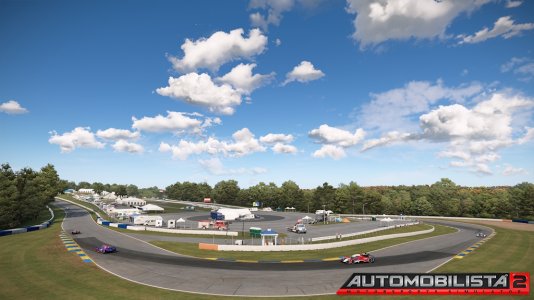There are a few important things:
Sol afaik always increases the workload for both cpu and gpu!
I'm not sure if the lowest settings (performance preset afaik in the sol app?) is less demanding than the default weather though.
However the big thing is CSP:
- there are quite a few good cpu optimizations available and selected at default
- there is hardware accelerated custom font rendering for hud apps!!!
- there is a lot of extra stuff that definitely puts more work on the cpu and especially the gpu.
Example:
I'm using basically everything from csp.
I did a benchmark via afterburner, playing the first lap of our zandvoort race (32 multiplayer) in cockpit view.
Result:
With csp: 105 fps average, 70-80% gpu load on my 3070 at 3440x1440. Cpu bottleneck
Without csp: 83 fps average, 30-40% gpu load, very clear cpu bottleneck
So you can see that the cpu optimizations from csp gain me 22 fps on average but also all the extra goodies double my graphics card load.
The main cpu issue with AC are the hud apps, reflection update rate and general polygon count.
So no hud, reflections on static and reduced world details are the most important settings for high fps. Also disabling post processing is quite a huge impact but you also lose a lot of visual quality and no brake lights anymore!
With csp, the impact of the hud apps is massively reduced (custom font rendering).
The issue here is that ac has 2 big main cpu threads (process explorer - properties of the running ac exe - threads) And the hud apps are rendered inside of the bigger of these 2 threads.
When your cpu has 3 cores or more, that one big thread will hit the single thread performance limit of your cpu instead of all threads together reaching the overall cpu limit.
So while only at 8.3% overall cpu load with a 12 thread cpu (100% / 12 threads = 8.33% maximum per cpu thread), the fps are bottlenecked by it.
In reality windows spreads the load on multiple cores very quickly so in Taskmanager it looks like all cores are used, but not fully.
But that's only an average! If Taskmanager would update with the cpu clockspeed, you would actually see each core getting to full load and then idling while the next core get to full load.
1s refresh rate in Taskmanager means 4.9 mrd cpu cycles averaged on my 4.9 GHz cpu clock.
I did a huge benchmark afternoon for acc and deactivated hyperthreading and cores on my 10600k.
After having 5 active cores, activating the 6th core didn't gain me anything.
Hyperthreading even caused lower fps!
With only 4 cores, hyperthreading increased fps by quite a bit but not as much as activating the 5th core!
ACC uses one more big thread, especially with AI instead of multiplayer.
So for ac, 4 cpu cores are fine, in theory. It's getting close though, as we can see from the 80-90% cpu load for Brian!
About cpu upgrades:
For simracing you need Single core, single core and single core performance!
And then 5 cores minimum to have some headroom.
AMD 3600: way lower single core performance compared to Intels 9th or 10th gen. The issue mainly is that you can easily slap a 9600k to 5 GHz on all cores but with amd it's a bit more complicated from what I've read.
The confusing thing is that single core benchmarks look very good for the amds. But when you play a game, the boost will drop, since the cpu slightly loads 3-5 cores and not just 1 core. When you overclock all cores, it will only become stable at so much lower clocks, that letting the cpu boost automatically actually gives more fps.
With pbo you can increase this boosting though.
Intel 8th, 9th,10th Gen:
Basically the same single core performance. More cores, hyperthreading, new chipsets and with 10th core even a new socket.
6 cores would be a nice upgrade for you! But I'm not sure that your board is compatible with the 8700k. Also you would first need to find a cheap 8700k... Or 8600k.
AMD 5600x: hands down best gaming cpu right now. Blows Intel 10th Gen out of the water in single core performance.
Problem: current situation inflated the price!
Second problem: amd is known for upgrade compatibility but Ryzen 5000 is the last gen with ddr4 and the current socket.
Intel 11th gen: will probably very slightly beat amd 5000 in single core performance and will be plug & play with 10th Gen z490 boards.
But it will very likely be less energy efficient than amd 5000...
I'm definitely getting a i5 11600k to easily gain 20% fps compared to my 10600k.
Issue: also last gen on ddr4 so no future compatibility...
About Intel: they used the skylake architecture and 14 nanometer process for 6th,7th,8th,9th,10th Gen. Only slight updates...
11th Gen will be using the architecture that was planned for the 10nm process. It got upscaled to 14nm now.
Upgrades for you:
- 7700k for not more than 50 pounds on top (after selling the 7600k)
Thid would only give you hyperthreading. Headroom for background processes but only a few fps...
- 8600k/8700k for not more than 100/130 pounds difference. Make sure that it's compatible with your exact mobo!
This would give you 2 cores and a bit of general speed. Probably 10-15% higher fps.
- amd 5600x + b550 mobo
This would be a huuuuge fps boost! Easily 100 fps in ac at all times.
- upcoming Intel 11600k + z490 mobo
Same as 5600x and no cold feet in winter

PC Hardware market is a mess right now... I hope the 11600k won't be more than 280€ and actually available...
Question: what's your actual cpu clock with 18% auto oc? You should download hwinfo64, run it in "sensors only" config (you can select that when starting it) and check the maximum for each core and also the max temperature for each core.
Just start it, then watch a replay for 5 minutes or do a quick race with 20 ai and then check the maximums.
Noctua u9s is great for its size but might struggle, when you push the 7600k to the limit..












